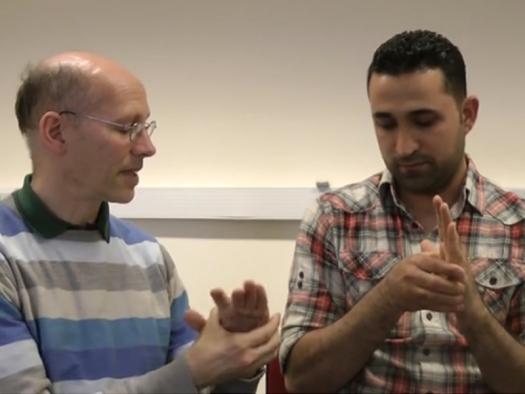EFTStressManagement.jpg

Screenshot from Stress Management 2 video by Solace on EFT
Advances in biomedical care for cancer have not been matched by achievements in providing high-quality care for the psychological and social effects of cancer. Numerous cancer survivors and their caregivers report that cancer care providers did not understand their psychosocial needs, failed to recognize and adequately address depression and other symptoms of stress, were unaware of or did not refer them to available resources, and generally did not consider psychosocial support to be an integral part of quality cancer care. The Cancer Council (Australia) suggests nearly 50 percent of cancer patients are not offered help for emotional distress and up to one in five cancer patients are never asked about their emotional wellbeing at their hospital appointments.
The benefits of an emerging stress reduction technique, Emotional Freedom Techniques (EFT), have indicated improvement in psychological distress, quality of life, and various mental illnesses. As a stress reduction technique, EFT has been well supported by clinical research. However, the effects of EFT intervention on cancer patients’ well-being has not been well explored.
EFT is a manualised evidence-based stress reduction technique that utilises elements of cognitive therapy with physical stimulation of acupressure points (Church, 2013a). Efficacy has been established for depression, anxiety, phobias, and posttraumatic stress disorder (PTSD, Church 2013b) and changes in biochemistry such as cortisol, blood pressure, immunity and an epigenetic potential to affect gene expression associated with PTSD symptomology has been established (Bach et al., 2019; Church et al., 2012; Church et al., 2018; Stapleton et al., 2020). Systematic reviews and meta-analyses have indicated large effects for anxiety, depression and PTSD (Church et al., 2018b; Clond, 2016; Nelms & Castel, 2016; Sebastian & Nelms, 2017). EFT is suggested to affect amygdala activity, and the hippocampus (memory), both of which play a role in the decision process when one decides whether something is a threat. EFT has also been shown to lower cortisol levels (Church et al., 2012; Stapleton et al., 2020) and deactivate neural mechanisms that trigger undesirable emotions or behaviours. It is therefore logical that reducing this limbic system hyperarousal will allow for greater prefrontal cortex activity.
The EFT process involves patients rating a concern (e.g., distressed feeling or discomfort) on a Subjective Unit of Distress scale (SUDS; Wolpe, 1973) zero to 10. A subjective measure of zero would represent an absence of distress and 10 would be the highest rating. Patients then vocalise their distress in a setup statement accompanied by an acceptance statement while physically tapping with two fingers on the side of the hand point (see Figure 1). For example, “Even though I have this worry about xxxx, I accept I feel this way”. The patient then manually stimulates (taps) the acupressure points in Figure 2, while stating a reminder phrase from the setup statement (usually the main concern e.g., “this worry”). The process is typically repeated until the patient’s SUDS rating is low.
EFT has been explored in two previous trials for cancer patient. The first aimed to improve the mood state, menopausal symptoms, fatigue, and pain in women with breast cancer who were receiving hormonal therapies (Baker & Hoffman, 2014). After one session of EFT (three hours per week) over three weeks, followed by self-application of the technique in the following nine weeks, statistically significant improvements (at both 6 and 12 weeks follow-up) in Total Mood Disturbance (anxiety, depression, and fatigue,) occurred compared to baseline.
The second study aimed to explore the effect of Spiritual EFT intervention to reduce of cancer pain patients (Hakam et al., 2009). The intervention group received SEFT intervention for 5-10 minutes every day over five days combined with analgesic therapy and the control group given only analgesic therapy. The combination SEFT intervention and analgesic therapy was more effective than only analgesic therapy.
Because it has been reported cancer patients currently receive little psychological support during medical treatment, it was of interest to explore how EFT could better support their emotional needs. This pilot study explored the effect of EFT delivered in a group setting, on individuals’ psychological well-being, compared to a treatment-as-usual group. This was in collaboration with the National Institute of Integrative Medicine in Australia.
Specifically, we hypothesised that patients who undertook EFT training would demonstrate better anxiety, depression, quality of life, Post Traumatic Stress symptoms, pain, happiness, trait hope, and meaning in life level than those who did not. In this study, 32 cancer patients were randomly assigned to either the EFT treatment condition or treatment as usual (TAU) condition. The current study employed a mixed factorial design. All self-report measures including The Hospital Anxiety and Depression Scale, The Quality of Life in Cancer Patients Measure, Brief PTSD Checklist, Single Item on Pain and Happiness, The Trait Hope Scale, and Meaning in Life Questionnaire, were administered before and after treatment. We also completed salivary cortisol testing pre and post each EFT session. Each EFT session was 2-hours and in total ran for 4-weeks (8 hours of EFT). These were facilitated by a clinical psychologist and trained EFT practitioner. Sessions were initially in person and completed in small groups of 5-6 patients only. No terminally ill patients were included, and some groups were delivered online, live via Zoom, after COVID-19 resulted in lockdown processes.
Overall participants in the EFT condition demonstrated a significant improvement in anxiety (p = .045) but no other measure. However, improvement trends in meaning of life, Quality of Life, post-traumatic stress disorder symptoms, and happiness were also observed (e.g. p=0.056). Every patient had a reduction in cortisol results for every session. Patients in the TAU group did not have any change across any measure.
The current study provided preliminary evidence for the comparative effectiveness of EFT for cancer patients for anxiety reduction and indicated significant outcomes may occur for other variables with larger sample sizes. A funding proposal is currently under review (2021) to extend this research to a full randomised clinical trial.
References
Bach, D., Groesbeck, G., Stapleton, P., Sims, R., Blickheuser, K., & Church, D. (2019). Clinical EFT (Emotional Freedom Techniques) Improves Multiple Physiological Markers of Health. Journal of Evidence-Based Integrative Medicine, 24. https://doi.org/10.1177/2515690X18823691
Baker, B. Hoffman, C. (2014). Emotional Freedom Techniques (EFT) to reduce the side effects associated with tamoxifen and aromatase inhibitor use in women with breast cancer: A service evaluation. European Journal of Integrative Medicine, 7(2), 136-42.
Church, D. (2013a). The EFT Manual. Energy Psychology Press: USA.
Church, D. (2013b). Clinical EFT as an evidence-based practice for the treatment of psychological and physiological conditions. Psychology, 4(08), 645. doi: 10.4236/psych.2013.48092
Church, D., Yount, G., & Brooks, A. (2012). The effect of emotional freedom techniques on stress biochemistry: a randomised controlled trial. The Journal of Nervous and Mental Disease, 200(10), 891-896. doi:10.1097/NMD.0b013e31826b9fc1
Church, D., Yount, G., Rachlin, K., Fox, L., & Nelms, J. (2018a). Epigenetic Effects of PTSD Remediation in Veterans Using Clinical Emotional Freedom Techniques: A Randomized Controlled Pilot Study. American Journal of Health Promotion, 32(1), 112-122. doi: 10.1177/0890117116661154
Church, D., Stapleton, P., Yang, A., & Gallo, F. (2018b). Is Tapping on Acupuncture Points an Active Ingredient in Emotional Freedom Techniques? A Systematic Review and Meta-analysis of Comparative Studies. The Journal of Nervous and Mental Disease, 206(10), 783-793. doi:10.1097/NMD.0000000000000878
Clond, M. (2016). Emotional Freedom Techniques for Anxiety A Systematic Review With Meta-analysis. Journal Of Nervous And Mental Disease, 204(5), 388-395. doi: 10.1097/NMD.0000000000000483
Hakam, M., Yetti, K., & Hariyati, T. S. (2009). Spiritual emotional freedom technique intervention to reduce pain in cancer patients. Makara Journal of Health Research, 13(2). doi:10.7454/msk.v13i2.375
Nelms, J., & Castel, L. (2016). A Systematic Review and Meta-Analysis of Randomised and Nonrandomized Trials of Clinical Emotional Freedom Techniques (EFT) for the Treatment of Depression. Explore: The Journal of Science and Healing, 12(6), 416-426. doi: 10.1016/j.explore.2016.08.001
Sebastian, B., & Nelms, J. (2017). The Effectiveness of Emotional Freedom Techniques in the Treatment of Posttraumatic Stress Disorder: A Meta-Analysis. Explore: The Journal of Science and Healing, 13(1), 16-25. doi: 10.1016/j.explore.2016.10.001
Stapleton, P., Crighton, G., Sabot, D., & O'Neill, H. M. (2020). Reexamining the effect of emotional freedom techniques on stress biochemistry: A randomized controlled trial. Psychological Trauma: Theory, Research, Practice, and Policy, 12(8), 869-877. https://doi.org/10.1037/tra0000563
Wolpe J. (1973). The Practice of Behavior Therapy. 2nd ed. New York, NY: Pergamon Press.


